Case Study: System Analysis of Auto-Parts Warehouse Management System
VerifiedAdded on 2023/01/05
|8
|906
|91
Case Study
AI Summary
This case study presents a system analysis of an auto-parts warehouse management system, addressing the need to improve efficiency and reduce costs. The analysis includes the identification of functional and non-functional requirements, such as stock management, database maintenance, and system responsiveness. The assignment further explores the system's design through a use case diagram, domain model class diagrams, and an event partition system model. The case study aims to provide a comprehensive understanding of the system's components and functionalities to optimize warehouse operations. The student has provided a detailed analysis of the auto-parts warehouse management system, covering critical aspects of its design and functionality, including diagrams and requirements. The analysis is based on a real-world scenario, making it a valuable resource for students studying business development and system analysis.
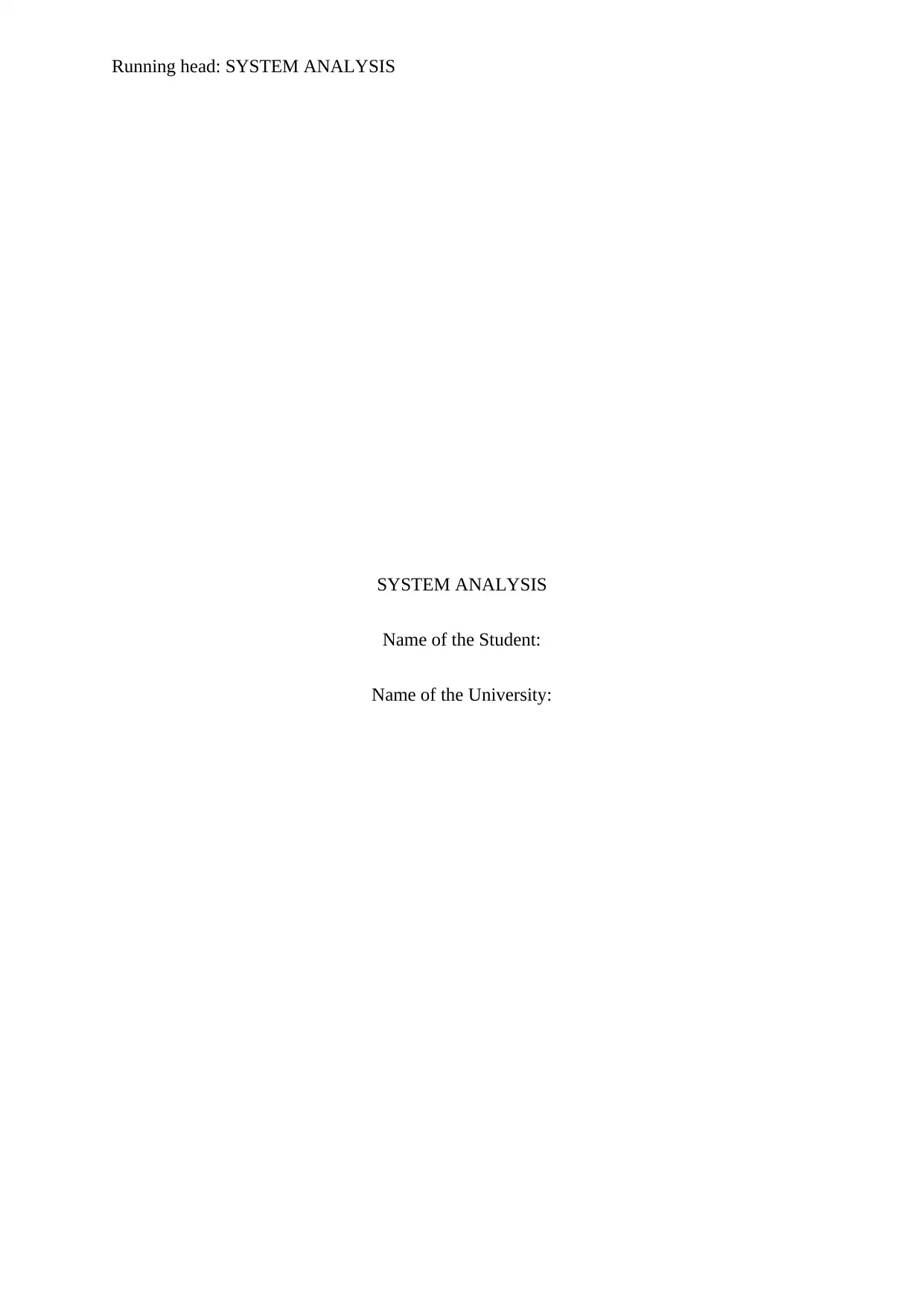
Running head: SYSTEM ANALYSIS
SYSTEM ANALYSIS
Name of the Student:
Name of the University:
SYSTEM ANALYSIS
Name of the Student:
Name of the University:
Paraphrase This Document
Need a fresh take? Get an instant paraphrase of this document with our AI Paraphraser
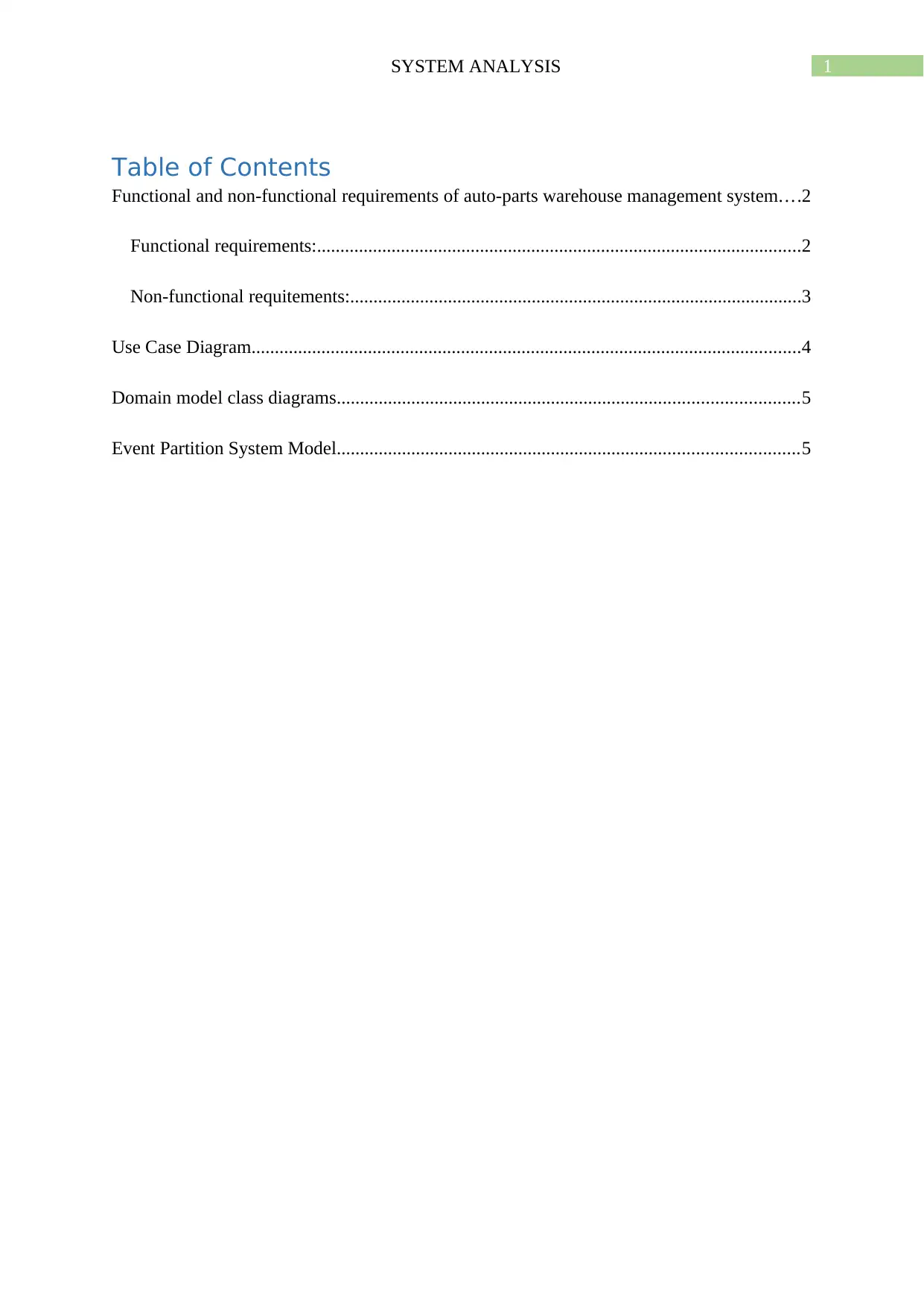
1SYSTEM ANALYSIS
Table of Contents
Functional and non-functional requirements of auto-parts warehouse management system....2
Functional requirements:........................................................................................................2
Non-functional requitements:.................................................................................................3
Use Case Diagram......................................................................................................................4
Domain model class diagrams...................................................................................................5
Event Partition System Model...................................................................................................5
Table of Contents
Functional and non-functional requirements of auto-parts warehouse management system....2
Functional requirements:........................................................................................................2
Non-functional requitements:.................................................................................................3
Use Case Diagram......................................................................................................................4
Domain model class diagrams...................................................................................................5
Event Partition System Model...................................................................................................5
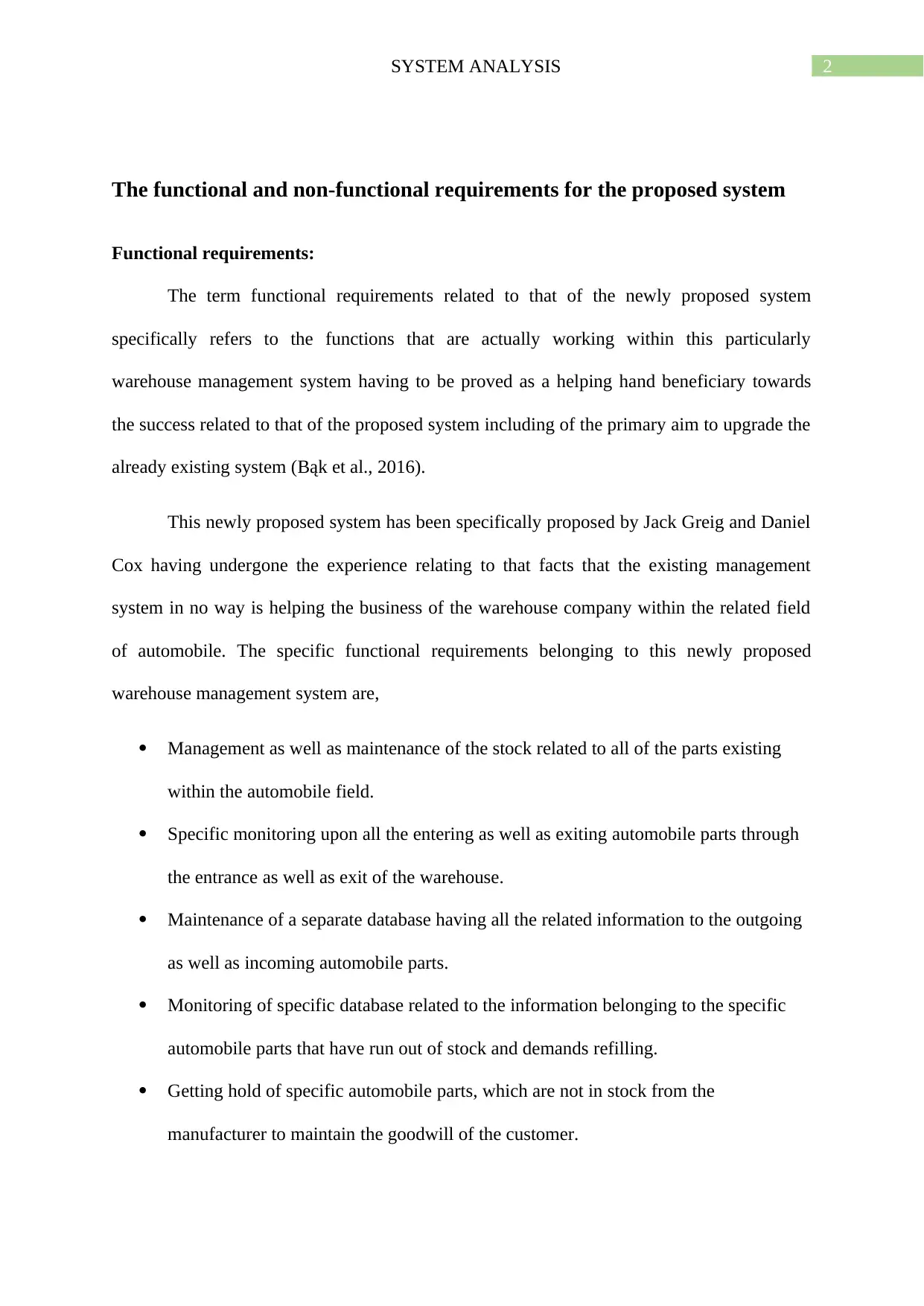
2SYSTEM ANALYSIS
The functional and non-functional requirements for the proposed system
Functional requirements:
The term functional requirements related to that of the newly proposed system
specifically refers to the functions that are actually working within this particularly
warehouse management system having to be proved as a helping hand beneficiary towards
the success related to that of the proposed system including of the primary aim to upgrade the
already existing system (Bąk et al., 2016).
This newly proposed system has been specifically proposed by Jack Greig and Daniel
Cox having undergone the experience relating to that facts that the existing management
system in no way is helping the business of the warehouse company within the related field
of automobile. The specific functional requirements belonging to this newly proposed
warehouse management system are,
Management as well as maintenance of the stock related to all of the parts existing
within the automobile field.
Specific monitoring upon all the entering as well as exiting automobile parts through
the entrance as well as exit of the warehouse.
Maintenance of a separate database having all the related information to the outgoing
as well as incoming automobile parts.
Monitoring of specific database related to the information belonging to the specific
automobile parts that have run out of stock and demands refilling.
Getting hold of specific automobile parts, which are not in stock from the
manufacturer to maintain the goodwill of the customer.
The functional and non-functional requirements for the proposed system
Functional requirements:
The term functional requirements related to that of the newly proposed system
specifically refers to the functions that are actually working within this particularly
warehouse management system having to be proved as a helping hand beneficiary towards
the success related to that of the proposed system including of the primary aim to upgrade the
already existing system (Bąk et al., 2016).
This newly proposed system has been specifically proposed by Jack Greig and Daniel
Cox having undergone the experience relating to that facts that the existing management
system in no way is helping the business of the warehouse company within the related field
of automobile. The specific functional requirements belonging to this newly proposed
warehouse management system are,
Management as well as maintenance of the stock related to all of the parts existing
within the automobile field.
Specific monitoring upon all the entering as well as exiting automobile parts through
the entrance as well as exit of the warehouse.
Maintenance of a separate database having all the related information to the outgoing
as well as incoming automobile parts.
Monitoring of specific database related to the information belonging to the specific
automobile parts that have run out of stock and demands refilling.
Getting hold of specific automobile parts, which are not in stock from the
manufacturer to maintain the goodwill of the customer.
⊘ This is a preview!⊘
Do you want full access?
Subscribe today to unlock all pages.

Trusted by 1+ million students worldwide
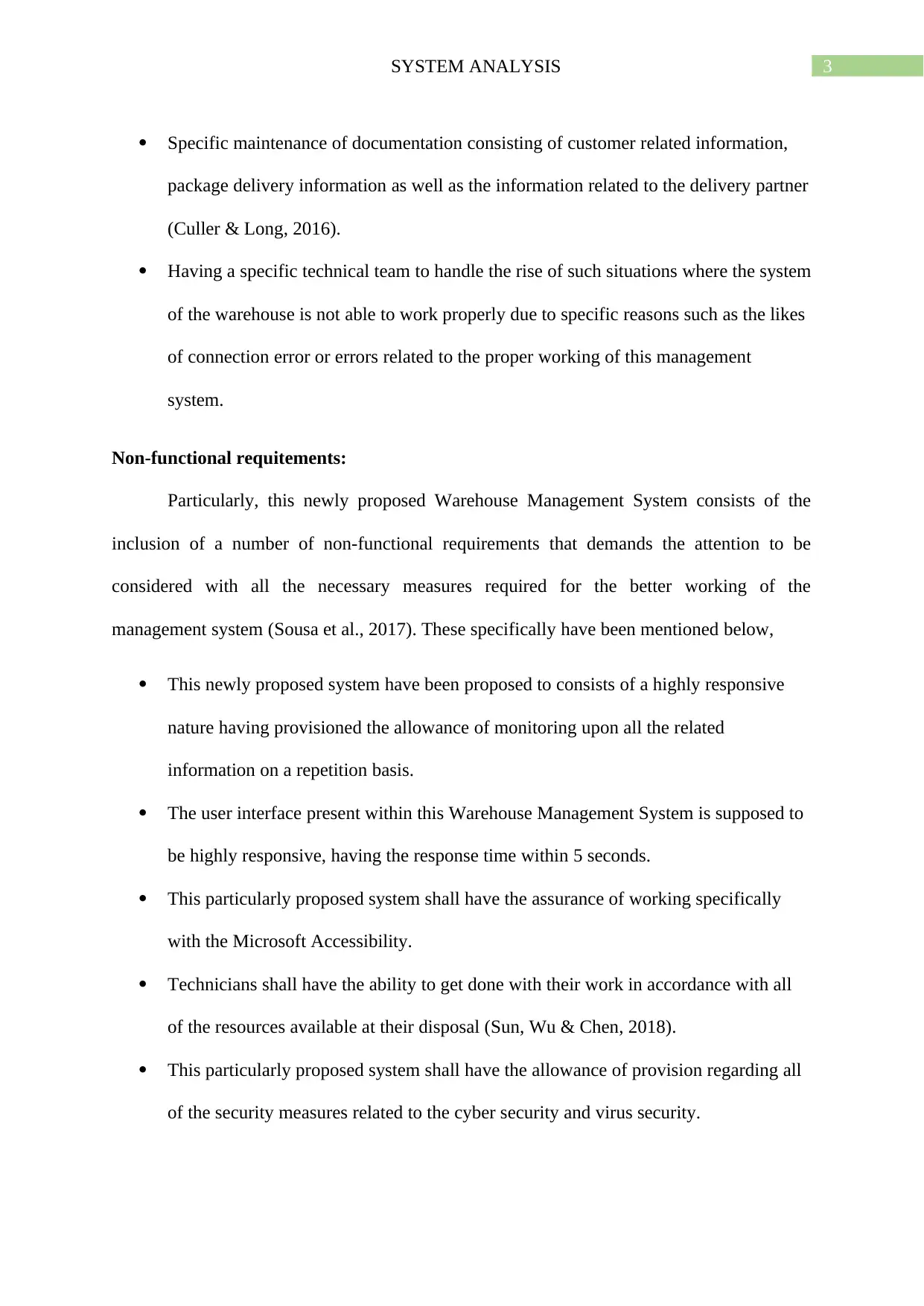
3SYSTEM ANALYSIS
Specific maintenance of documentation consisting of customer related information,
package delivery information as well as the information related to the delivery partner
(Culler & Long, 2016).
Having a specific technical team to handle the rise of such situations where the system
of the warehouse is not able to work properly due to specific reasons such as the likes
of connection error or errors related to the proper working of this management
system.
Non-functional requitements:
Particularly, this newly proposed Warehouse Management System consists of the
inclusion of a number of non-functional requirements that demands the attention to be
considered with all the necessary measures required for the better working of the
management system (Sousa et al., 2017). These specifically have been mentioned below,
This newly proposed system have been proposed to consists of a highly responsive
nature having provisioned the allowance of monitoring upon all the related
information on a repetition basis.
The user interface present within this Warehouse Management System is supposed to
be highly responsive, having the response time within 5 seconds.
This particularly proposed system shall have the assurance of working specifically
with the Microsoft Accessibility.
Technicians shall have the ability to get done with their work in accordance with all
of the resources available at their disposal (Sun, Wu & Chen, 2018).
This particularly proposed system shall have the allowance of provision regarding all
of the security measures related to the cyber security and virus security.
Specific maintenance of documentation consisting of customer related information,
package delivery information as well as the information related to the delivery partner
(Culler & Long, 2016).
Having a specific technical team to handle the rise of such situations where the system
of the warehouse is not able to work properly due to specific reasons such as the likes
of connection error or errors related to the proper working of this management
system.
Non-functional requitements:
Particularly, this newly proposed Warehouse Management System consists of the
inclusion of a number of non-functional requirements that demands the attention to be
considered with all the necessary measures required for the better working of the
management system (Sousa et al., 2017). These specifically have been mentioned below,
This newly proposed system have been proposed to consists of a highly responsive
nature having provisioned the allowance of monitoring upon all the related
information on a repetition basis.
The user interface present within this Warehouse Management System is supposed to
be highly responsive, having the response time within 5 seconds.
This particularly proposed system shall have the assurance of working specifically
with the Microsoft Accessibility.
Technicians shall have the ability to get done with their work in accordance with all
of the resources available at their disposal (Sun, Wu & Chen, 2018).
This particularly proposed system shall have the allowance of provision regarding all
of the security measures related to the cyber security and virus security.
Paraphrase This Document
Need a fresh take? Get an instant paraphrase of this document with our AI Paraphraser
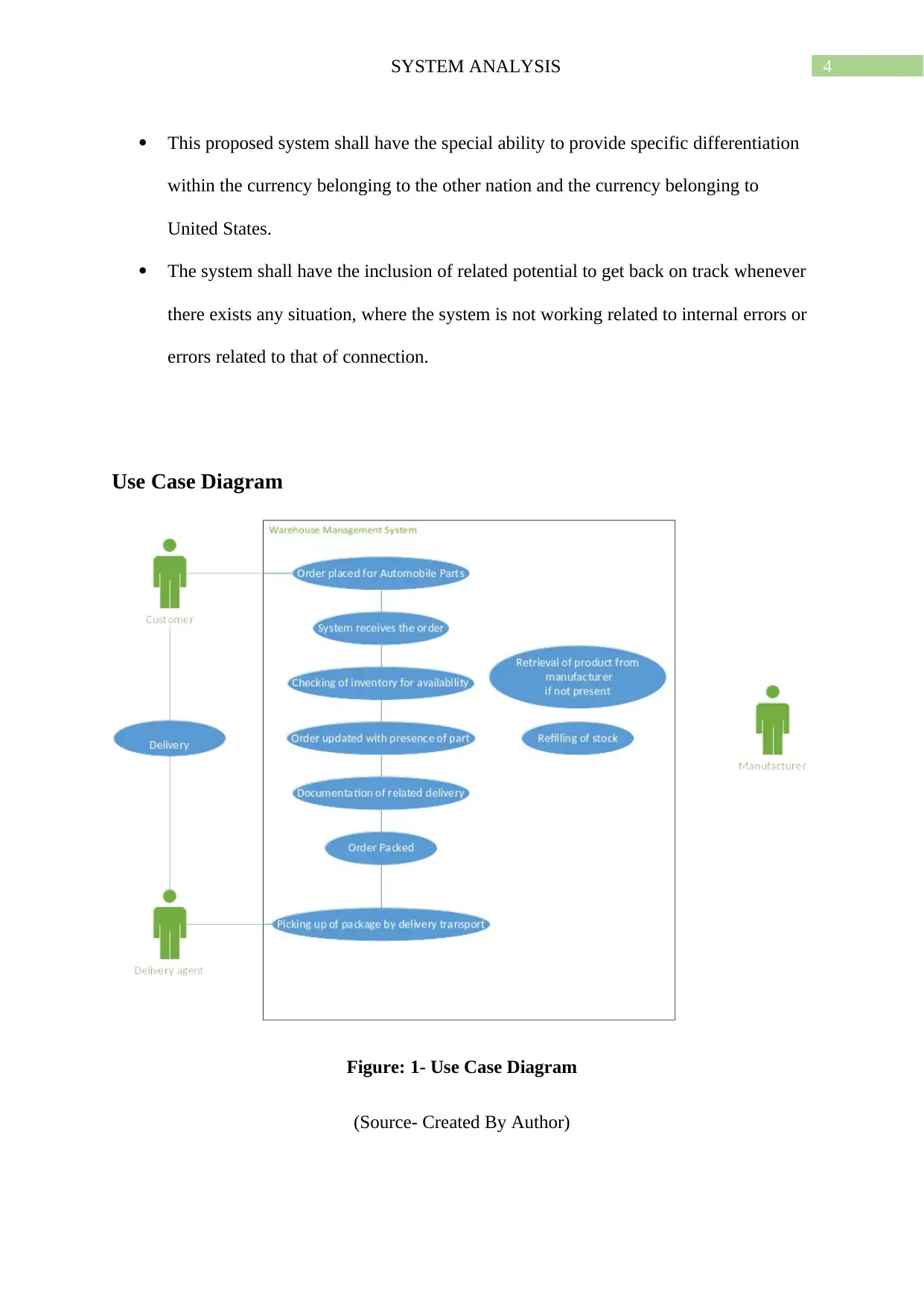
4SYSTEM ANALYSIS
This proposed system shall have the special ability to provide specific differentiation
within the currency belonging to the other nation and the currency belonging to
United States.
The system shall have the inclusion of related potential to get back on track whenever
there exists any situation, where the system is not working related to internal errors or
errors related to that of connection.
Use Case Diagram
Figure: 1- Use Case Diagram
(Source- Created By Author)
This proposed system shall have the special ability to provide specific differentiation
within the currency belonging to the other nation and the currency belonging to
United States.
The system shall have the inclusion of related potential to get back on track whenever
there exists any situation, where the system is not working related to internal errors or
errors related to that of connection.
Use Case Diagram
Figure: 1- Use Case Diagram
(Source- Created By Author)
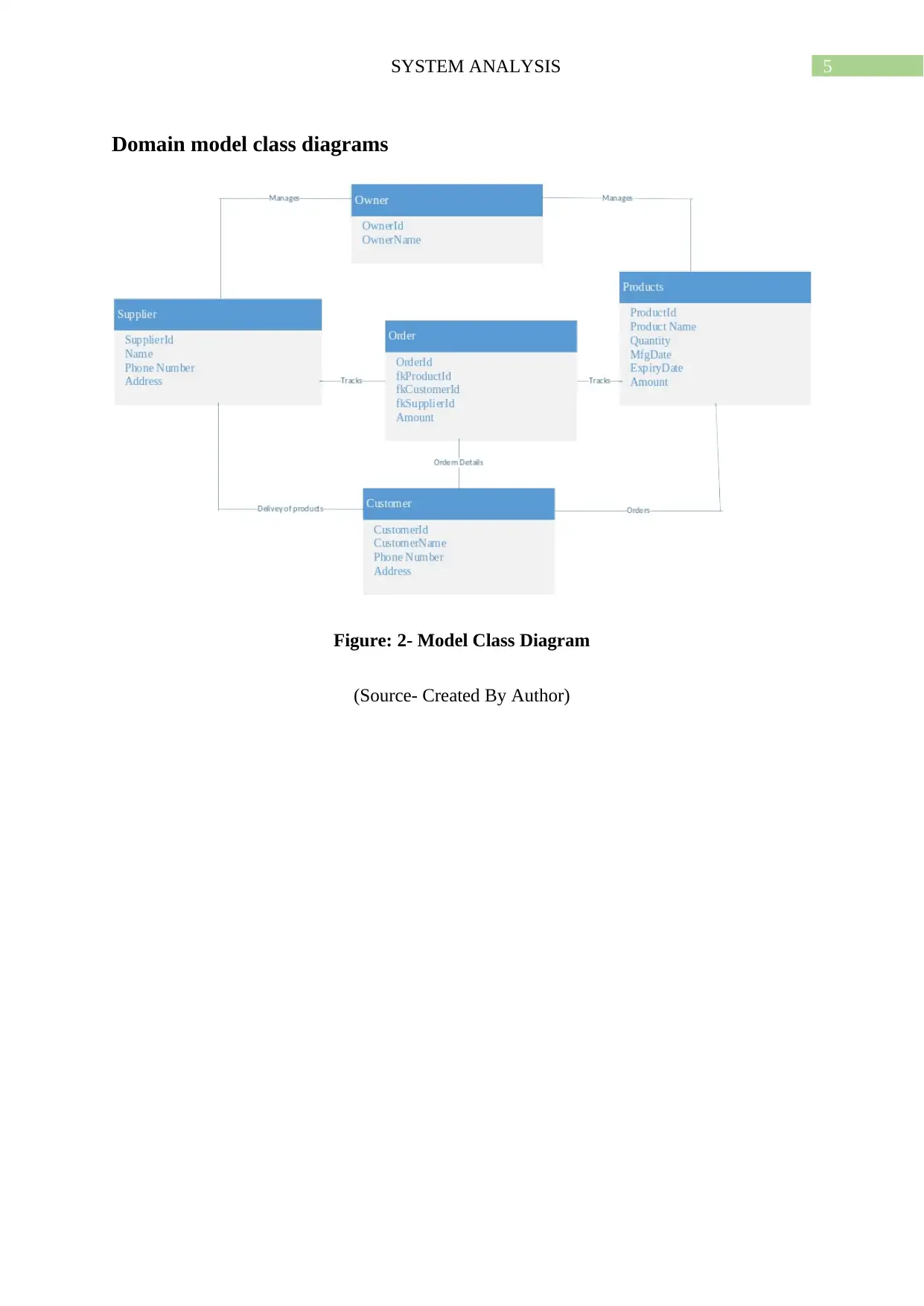
5SYSTEM ANALYSIS
Domain model class diagrams
Figure: 2- Model Class Diagram
(Source- Created By Author)
Domain model class diagrams
Figure: 2- Model Class Diagram
(Source- Created By Author)
⊘ This is a preview!⊘
Do you want full access?
Subscribe today to unlock all pages.

Trusted by 1+ million students worldwide
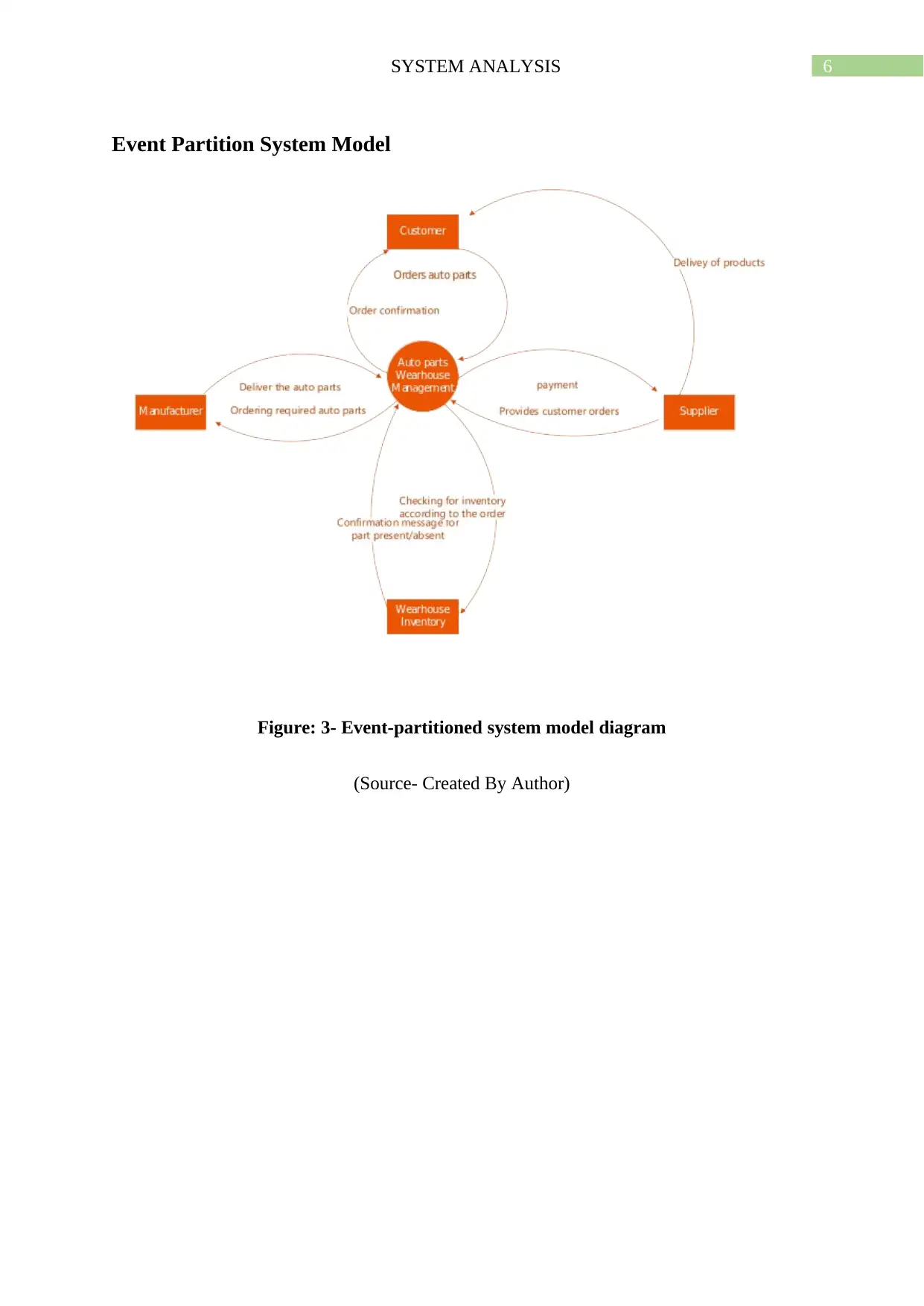
6SYSTEM ANALYSIS
Event Partition System Model
Figure: 3- Event-partitioned system model diagram
(Source- Created By Author)
Event Partition System Model
Figure: 3- Event-partitioned system model diagram
(Source- Created By Author)
Paraphrase This Document
Need a fresh take? Get an instant paraphrase of this document with our AI Paraphraser
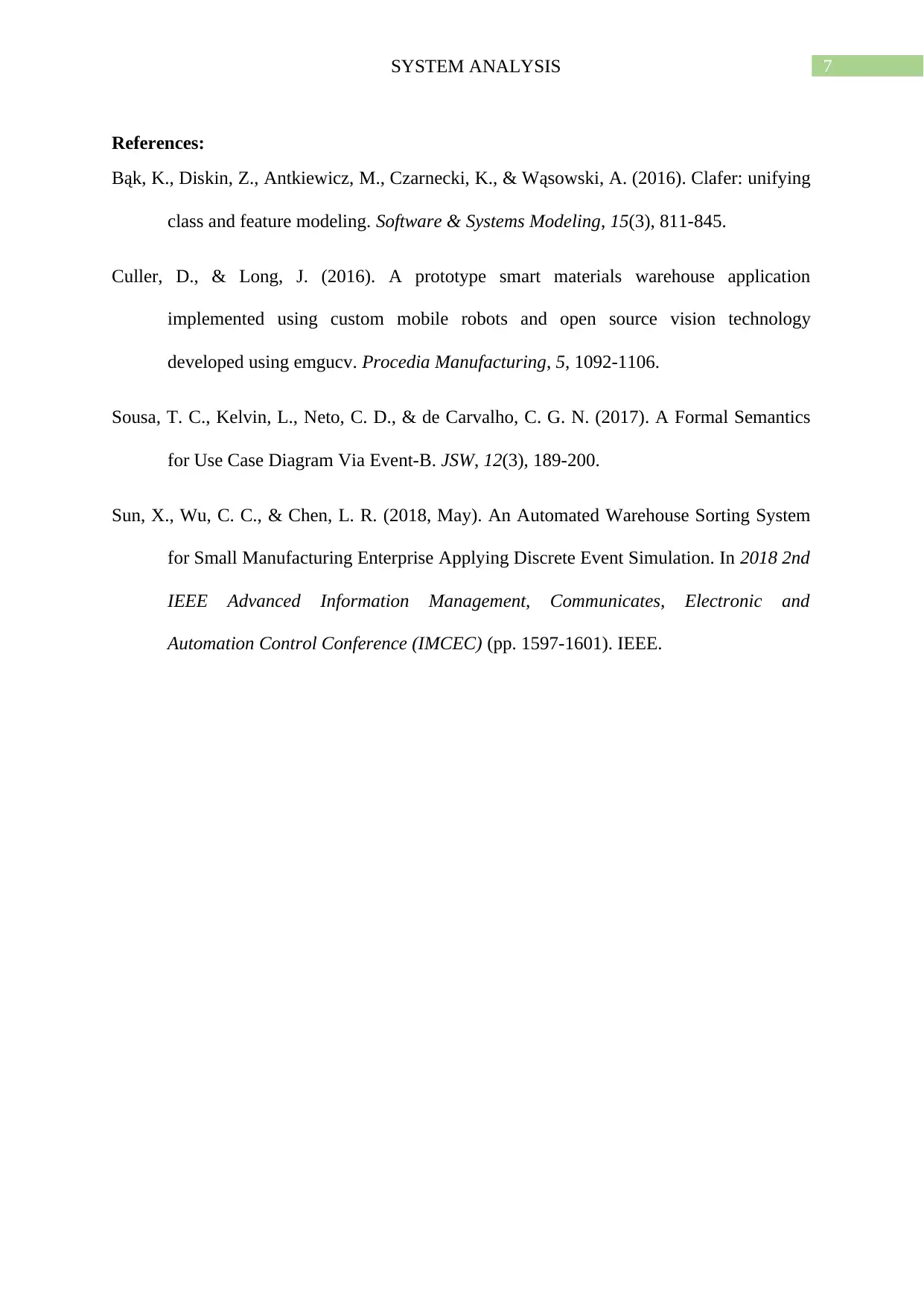
7SYSTEM ANALYSIS
References:
Bąk, K., Diskin, Z., Antkiewicz, M., Czarnecki, K., & Wąsowski, A. (2016). Clafer: unifying
class and feature modeling. Software & Systems Modeling, 15(3), 811-845.
Culler, D., & Long, J. (2016). A prototype smart materials warehouse application
implemented using custom mobile robots and open source vision technology
developed using emgucv. Procedia Manufacturing, 5, 1092-1106.
Sousa, T. C., Kelvin, L., Neto, C. D., & de Carvalho, C. G. N. (2017). A Formal Semantics
for Use Case Diagram Via Event-B. JSW, 12(3), 189-200.
Sun, X., Wu, C. C., & Chen, L. R. (2018, May). An Automated Warehouse Sorting System
for Small Manufacturing Enterprise Applying Discrete Event Simulation. In 2018 2nd
IEEE Advanced Information Management, Communicates, Electronic and
Automation Control Conference (IMCEC) (pp. 1597-1601). IEEE.
References:
Bąk, K., Diskin, Z., Antkiewicz, M., Czarnecki, K., & Wąsowski, A. (2016). Clafer: unifying
class and feature modeling. Software & Systems Modeling, 15(3), 811-845.
Culler, D., & Long, J. (2016). A prototype smart materials warehouse application
implemented using custom mobile robots and open source vision technology
developed using emgucv. Procedia Manufacturing, 5, 1092-1106.
Sousa, T. C., Kelvin, L., Neto, C. D., & de Carvalho, C. G. N. (2017). A Formal Semantics
for Use Case Diagram Via Event-B. JSW, 12(3), 189-200.
Sun, X., Wu, C. C., & Chen, L. R. (2018, May). An Automated Warehouse Sorting System
for Small Manufacturing Enterprise Applying Discrete Event Simulation. In 2018 2nd
IEEE Advanced Information Management, Communicates, Electronic and
Automation Control Conference (IMCEC) (pp. 1597-1601). IEEE.
1 out of 8
Related Documents
Your All-in-One AI-Powered Toolkit for Academic Success.
+13062052269
info@desklib.com
Available 24*7 on WhatsApp / Email
![[object Object]](/_next/static/media/star-bottom.7253800d.svg)
Unlock your academic potential
Copyright © 2020–2025 A2Z Services. All Rights Reserved. Developed and managed by ZUCOL.


